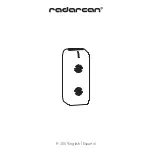
8 - STANDARD CONTROL OPERATIONS AND OPTIONS
8.6.2 Reset calculation
Reset means that the active setpoint is modified so that less
machine capacity is required in order to satisfy the current
demand.
In the cooling mode the setpoint is increased, whereas in the
heating mode it is usually decreased.
The reset can be based on the following factors (sources):
OAT that gives the measure of the load trends for the
building.
Return water temperature (ΔT provides the average
building load).
Space temperature (Energy Management Module).
Dedicated 4-20 mA input (Energy Management Module).
The reset source as well as reset parameters can be configured
via the CONNECT TOUCH user interface (RESETCFG – Reset
Configuration).
In response to a drop in the reset source, e.g. OAT, the
cooling setpoint is normally reset upwards to optimise the unit
performance.
The reset value is determined by linear interpolation based on
the following parameters:
A reference at which the reset is zero = no reset value
A reference at which the reset is maximum = full reset value
The maximum reset value
Reset example in Cooling mode:
B
C
A
°C
°C
100
%
3
0
20
25
D
% Building
Load
Reset value
20
Reset based on OAT
25
0
Reset based on delta T
3
4
Reset based on analog input
20
no_reset
Selection
full_reset
Legend:
A: Maximum reset value
B: Reference for zero reset
C: Reference for maximum reset
D: Building load
8.7
Capacity limitation
The CONNECT TOUCH control allows for the constant control
of the unit capacity. It is possible thanks to setting the unit's
maximum allowable capacity.
How to understand "capacity limitation"?
Capacity limitation is used to determine the maximum unit's
capacity. Capacity limitation is expressed in percentage, where
a limit value of 100% means that the unit may run with its full
capacity (no limitation is required).
The unit capacity can be limited as follows:
By means of user-controlled volt-free contacts. The unit
capacity can never exceed the setpoint limit activated by
these contacts.
By lag limit [LAG_LIM] set by the Master unit in the master/
slave assembly. If the unit is not in the master/slave
assembly, then the lag limit value is equal to 100%.
By night mode limitation control. The demand limit value
in the night mode is selectable if the value is below the
selected capacity limit.
To set limit setpoints
1. Navigate to the Main menu.
2. Select
Setpoint Configuration
(SETPOINT).
3. Set Switch Limit Setpoint 1 / 2 / 3 [lim_sp1 / 2 / 3].
Switch Limit Setpoint 1 / 2 / 3 [lim_sp1 / 2 / 3]
0 to 100%
100%
To verify lag limit set by the master unit
1. Navigate to the Main menu.
2. Select
General Parameters
(GENUNIT).
3. Verify Lag Capacity Limit Value [LAG_LIM].
Lag Capacity Limit Value [LAG_LIM]
0 to 100%
100%
To set the night mode limit
1. Navigate to the Configuration menu (logged-in users only).
2. Select
General Configuration
(GENCONF).
3. Set Night Capacity Limit [nh_limit].
Night Capacity Limit [nh_limit]
0 to 100%
100%
Active demand limit
Based on the limit source, the active demand limit value
[DEM_LIM] is set to the lowest possible value. The DEM_LIM
parameter can be forced by Network.
To verify active demand limit value
1. Navigate to the Main menu.
2. Select
General Parameters
(GENUNIT).
3. Verify Active Demand Limit Val [DEM_LIM].
Active Demand Limit Val [DEM_LIM]
0 to 100%
-
EN-43 AQUACIAT
POWER
Содержание AQUACIATPOWER ILD-HE Series
Страница 1: ...Instruction manual 05 2021 10536 CONNECT TOUCH AQUACIAT POWER I LD ST HE 602 2000...
Страница 2: ......














































